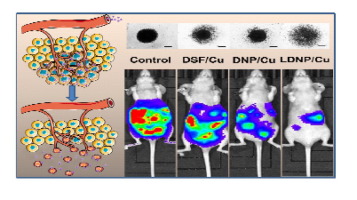Acta Biomaterialia ( IF 9.7 ) Pub Date : 2017-12-30 , DOI: 10.1016/j.actbio.2017.12.023 Huacheng He , Eleni Markoutsa , Jing Li , Peisheng Xu

|
Disulfiram (DSF), an FDA approved drug for the treatment of alcoholism, degrades to therapeutically active diethyldithiocarbamate (DDTC) in the body by reduction. Hereby, we developed a redox sensitive DDTC-polymer conjugate for targeted cancer therapy. It was found that the DDTC-polymer conjugate modified with a β-D-galactose receptor targeting ligand can self-assemble into LDNP nanoparticle and efficiently enter cancer cells by receptor-mediated endocytosis. Upon cellular uptake, the LDNP nanoparticle degrades and releases DDTC due to the cleavage of disulfide bonds, and subsequently forms copper (II) DDTC complex to kill a broad spectrum of cancer cells. 3D cell culture revealed that this nanoparticle shows much stronger tumor mass penetrating and destructive capacity. Furthermore, LDNP nanoparticles exhibited much greater potency in inhibiting tumor growth in a peritoneal metastatic ovarian tumor model.
Statement of Significance
The β-D-galactose receptor targeted disulfiram loaded nanoparticle (LDNP) is novel in the following aspects:
- 1.
Lactobionic acid (LBA) targets β-D-galactose receptor, which is a surface lectin that is overexpressed in various types of cancer cells, such as liver and ovarian cancers. The introducing of LBA ligand, endows the LDNP/Cu nanoparticle with stronger penetrating and destructive capacity in a tumor spheroid model.
- 2.
The premature release of disulfiram from the nanoparticle can be minimized through the formation of polymer-prodrug based LDNP.
- 3.
The LDNP nanoparticle fabricated from a polymer-disulfiram derivative conjugate can selectively kill a broad spectrum of cancer cells, while sparing normal cells.
- 4.
In vivo study carried out in a clinically relevant orthotopic ovarian tumor model revealed that LDNP/Cu exhibits stronger efficacy in inhibiting the progression of metastatic ovarian cancer than a dosage form used in clinical trial, while not inducing side effects.
中文翻译:

通过有针对性的纳米技术,通过增强的肿瘤大量渗透和拆卸,将二硫仑用于癌症治疗。
双硫仑(DSF)是FDA批准的用于治疗酒精中毒的药物,可通过还原作用降解为体内具有治疗活性的二乙基二硫代氨基甲酸酯(DDTC)。因此,我们开发了一种氧化还原敏感的DDTC-聚合物共轭物,用于靶向癌症治疗。发现用β-D-半乳糖受体靶向配体修饰的DDTC-聚合物缀合物可以自组装成LDNP纳米颗粒,并通过受体介导的内吞作用有效地进入癌细胞。细胞摄取后,LDNP纳米颗粒由于二硫键的裂解而降解并释放DDTC,随后形成铜(II)DDTC复合物以杀死广泛的癌细胞。3D细胞培养表明,这种纳米粒子显示出更强的肿瘤穿透能力和破坏力。此外,
重要声明
靶向β-D-半乳糖受体的双硫仑纳米颗粒(LDNP)在以下方面是新颖的:
- 1。
乳果糖酸(LBA)靶向β-D-半乳糖受体,这是一种表面凝集素,在各种类型的癌细胞(例如肝癌和卵巢癌)中过表达。LBA配体的引入使LDNP / Cu纳米颗粒在肿瘤球体模型中具有更强的穿透力和破坏力。
- 2。
通过形成基于聚合物-前药的LDNP,可以使二硫仑从纳米颗粒的过早释放最小化。
- 3。
由聚合物-双硫仑衍生物共轭物制成的LDNP纳米颗粒可以选择性杀死广泛的癌细胞,同时保留正常细胞。
- 4,
在临床上相关的原位卵巢肿瘤模型中进行的体内研究表明,与临床试验中使用的剂型相比,LDNP / Cu在抑制转移性卵巢癌进展方面显示出更强的功效,而不会引起副作用。



























 京公网安备 11010802027423号
京公网安备 11010802027423号